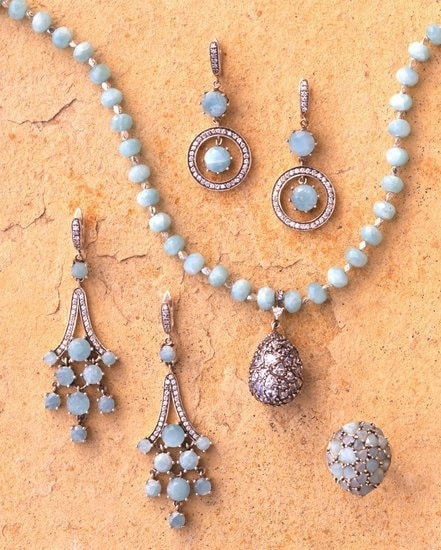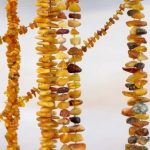Native beaded jewelry carries with it a rich history and cultural significance that spans across various indigenous cultures. In this article, we will dive into the world of native beaded jewelry and discover how these intricate pieces are not just accessories, but a reflection of tradition, artistry, and identity.
If you have ever wondered how to make native beaded jewelry, read on as we explore the essential materials needed, tips on choosing the right beads, basic beading techniques, design inspiration, creating patterns, adding finishing touches, and proper care and maintenance.
Beads come in a vast array of shapes, sizes, colors, and textures – each holding its own unique symbolism and meaning. Selecting the right beads for your project is crucial in capturing the essence of native beadwork. Whether you are drawn to vibrant hues inspired by nature or traditional patterns passed down through generations, learning how to choose beads that speak to you is the first step towards creating your own piece of native beaded jewelry.
From simple stringing to complex weaving techniques, mastering basic beading skills is fundamental in bringing your vision to life. As we delve into the step-by-step guide on basic beading techniques such as stitching and weaving in this article section dedicated to introducing you into Native Beaded Jewelry making.
Materials Needed
Creating beautiful native beaded jewelry is a fulfilling and creative craft that allows you to express your unique style while honoring the rich traditions of indigenous cultures. To get started on your beading journey, it is essential to gather the right materials. Here is a list of essential items you will need to create stunning native beaded jewelry:
- Beads: Choose from a wide variety of beads in different sizes, colors, shapes, and materials such as glass, seed beads, gemstones, or metal beads.
- Needles: Special beading needles are thin and flexible to easily thread through small bead holes. Make sure to have a variety of needle sizes for different bead sizes.
- Thread: Beading thread or cord is crucial for securing beads together. Opt for strong and durable threads like nylon or silk threads in various colors.
- Findings: Findings are essential components like clasps, jump rings, crimps, and wire guardians that help finish and secure your jewelry piece.
Now that you have gathered all the necessary materials, including beads, needles, thread, and findings; it’s time to unleash your creativity and start making your own native beaded jewelry pieces. The right materials will not only help you execute your design ideas effectively but also ensure the quality and durability of your finished pieces.
When selecting beads for your projects, consider factors like size, color scheme, texture, and material to achieve the desired look. Experiment with different combinations to find what resonates with you the most.
By understanding how these materials work together harmoniously in native beaded jewelry making process; you can create stunning pieces that reflect your individual style while paying homage to traditional craftsmanship techniques. Whether you are inspired by nature’s beauty or cultural symbols – the possibilities are endless when it comes to crafting unique native beaded jewelry pieces.
Choosing the Right Beads
When it comes to making Native beaded jewelry, selecting the right beads is crucial in bringing your vision to life. The type of beads you choose will greatly impact the overall look and feel of your piece. Here are some tips on how to choose the right beads for your project:
- Consider the size: Beads come in a variety of sizes, from tiny seed beads to larger focal beads. The size of the beads you choose will determine the overall scale and style of your jewelry piece.
- Take into account color: Color plays a significant role in Native American beadwork, with each color holding symbolic meaning. Choose colors that hold personal significance or represent elements from nature.
- Pay attention to texture: Beads come in different finishes and textures, such as matte, shiny, or iridescent. Consider how the texture of the beads will impact the overall look of your design.
By carefully selecting beads that align with your vision and design aesthetic, you can create a truly unique and meaningful piece of Native beaded jewelry.
Creating Native beaded jewelry involves a deep connection to tradition and culture, making each piece a work of art with its own story to tell. By understanding how different beads can convey different meanings and evoke specific emotions, you can infuse deeper symbolism into your designs.
Whether you are drawing inspiration from traditional patterns or letting your creativity guide you, choosing the right beads is an essential step in the process. Experimenting with different sizes, colors, and textures will allow you to create dynamic and visually captivating pieces that honor the rich history of Native American beadwork.
Basic Beading Techniques
Stringing
Stringing beads is one of the most basic and versatile techniques in making native beaded jewelry. To start, you will need a length of thread or wire, depending on the design of your piece. Choose your beads and begin by threading them onto the thread in the desired pattern. Use a clasp or jump ring to secure the ends of the thread and create a loop for closure. Stringing allows for endless possibilities in creating necklaces, bracelets, and even earrings.
Weaving
Weaving beads is another popular technique used in Native American beadwork. This technique involves creating intricate patterns by weaving beads together using a needle and thread. To weave beads, start with a foundation row of beads strung onto your thread. Then, use a needle to weave additional rows of beads through the existing ones to create a woven design. Weaving allows for detailed and complex patterns that can showcase traditional designs or modern creativity.
Stitching
Stitching beads is a technique that involves sewing individual beads onto fabric or leather to create beaded designs. This method is commonly used in creating beautiful pieces such as beaded cuffs, earrings, or hair accessories. Different stitching techniques like peyote stitch, brick stitch, and ladder stitch can be utilized to achieve various effects in native beaded jewelry. Experiment with different stitches to add texture and dimension to your creations while showcasing your unique style.
Design Inspiration
Traditional Patterns
One of the key sources of design inspiration for native beaded jewelry is traditional patterns passed down through generations. These patterns often hold cultural significance and can vary significantly between different indigenous communities. By studying and incorporating these traditional patterns into your beaded jewelry designs, you can pay homage to the rich history and heritage behind each piece.
Nature
Nature is another excellent source of inspiration for creating beautiful native beaded jewelry. From the vibrant colors of a sunset to the intricate patterns found in a seashell, nature provides endless possibilities for unique designs. By observing the world around you and translating elements of nature into your beadwork, you can create stunning pieces that reflect the beauty of the natural world.
Personal Creativity
While traditional patterns and nature can serve as starting points for your designs, don’t underestimate the power of your own creativity when making native beaded jewelry. Experiment with different color combinations, shapes, and textures to create one-of-a-kind pieces that truly reflect your personal style. Whether you’re drawn to bold and vibrant designs or subtle and understated pieces, let your imagination guide you in creating jewelry that speaks to your individuality.
By drawing inspiration from traditional patterns, nature, and your own creativity, you can craft unique and meaningful native beaded jewelry pieces that showcase both skillful craftsmanship and personal expression. Remember to stay true to yourself as an artist while also honoring the cultural roots of this timeless art form.
Creating Patterns
Creating intricate patterns and designs in native beaded jewelry is a true art form that requires skill, patience, and a good eye for detail. One of the key techniques used in creating patterns is the process of color patterning. This involves strategically placing beads of different colors to form a pattern or design on the jewelry piece. Whether you are following a traditional pattern or creating your own unique design, color patterning can truly make your beaded jewelry stand out.
Another technique for creating intricate patterns in native beaded jewelry is through the use of different bead shapes and sizes. By incorporating beads of various shapes such as round, seed beads, bugle beads, or even gemstone beads, you can add depth and dimension to your design. Mixing different sizes of beads within the same project can also create interesting textures and patterns that catch the eye.
When creating intricate patterns in native beaded jewelry, it’s important to pay attention to symmetry and balance. Whether you are working on a flat piece like a bracelet or a more complex piece like a necklace or earrings, ensuring that the pattern is even on both sides can make a significant difference in the overall look of the finished piece.
Taking the time to plan out your design and layout before starting can help you achieve a harmonious and visually appealing result.
| Key Techniques | Creating Patterns |
|---|---|
| Color Patterning | Incorporating different colors strategically to form patterns |
| Bead Shapes and Sizes | Using various bead shapes and sizes for depth and dimension |
| Symmetry and Balance | Ensuring evenness on both sides for visual appeal |
Adding Finishing Touches
Completing your native beaded jewelry piece involves adding the necessary finishing touches that will enhance its overall look and functionality. One important aspect to consider is choosing the right clasp for your jewelry design. Clasps not only secure your piece when worn but also serve as a decorative element.
There are various types of clasps available, such as lobster clasps, toggle clasps, and magnetic clasps. Consider the style and weight of your jewelry piece when selecting a clasp to ensure it complements the design.
In addition to clasps, embellishments can further elevate the aesthetic appeal of your native beaded jewelry. From charms and pendants to gemstones and crystals, there are endless options to add a touch of uniqueness to your piece. When choosing embellishments, think about the theme or inspiration behind your design. Whether you want to incorporate elements from nature or symbols representing cultural significance, carefully select embellishments that resonate with the overall concept of your jewelry.
Finally, finishes play a crucial role in completing your native beaded jewelry piece. Finishing techniques like patina, polishing, or sealing can help protect the beads and metals used in your design while giving it a professional look.
Ensure that the finishes you apply are suitable for the materials used in your jewelry to avoid any damage or discoloration over time. By paying attention to these finishing touches, you can create a stunning and durable native beaded jewelry piece that reflects your creativity and craftsmanship.
Remember that each element added during this stage should complement the overall design of your native beaded jewelry while also providing practical functionality for wearability. Experiment with different combinations of clasps, embellishments, and finishes to achieve a truly unique and personalized piece that showcases your skills in creating beautiful native beaded jewelry pieces.
Care and Maintenance
Native beaded jewelry is not just a craft but also a means of preserving tradition and culture. To ensure the longevity and beauty of your creations, proper care and maintenance are essential. Here are some guidelines on how to properly care for and store your native beaded jewelry.
First and foremost, it is important to handle your native beaded jewelry with care. Avoid exposing it to harsh chemicals, perfumes, or lotions that can tarnish the beads or damage the thread. When not wearing your jewelry, store it in a cool, dry place away from direct sunlight to prevent fading or discoloration.
Regular cleaning is also important in maintaining the beauty of your native beaded jewelry. Gently wipe down the beads with a soft, damp cloth to remove any dirt or oils that may have accumulated over time. For more delicate pieces, consider using a mild soap solution and a soft brush to clean intricate designs without damaging the beads.
Lastly, make sure to store your native beaded jewelry properly to prevent tangling or breakage. Consider using individual pouches or compartments to keep each piece separate and prevent them from rubbing against each other. By following these simple guidelines, you can enjoy your native beaded jewelry for years to come while preserving the artistry and craftsmanship behind each piece.
In conclusion, learning how to make native beaded jewelry not only allows you to create beautiful pieces but also connects you with rich cultural traditions. By properly caring for and storing your creations, you can ensure that they remain as stunning as the day you made them. Embrace the art form of native beaded jewelry-making and let your creativity shine through in each unique piece you create.
Frequently Asked Questions
What Do I Need for Native Beading?
To start native beading, you will need basic supplies such as beads (seed beads are commonly used), beading thread or wire, needles, scissors, and a bead mat for organization. Additionally, tools like pliers and bead boards can be useful for more intricate projects.
How Did Native Americans Make Beads for Jewelry?
Native Americans traditionally made beads for jewelry by using natural materials like shells, stones, bones, and seeds. These materials were carefully crafted into small pieces with holes drilled through them to string together. Later on, glass beads introduced by Europeans became a popular choice due to their wide variety of colors and sizes.
What Size Beads for Native American Beadwork?
The size of beads used in Native American beadwork varies depending on the specific tribe’s traditions and designs. However, generally speaking, seed beads are the most common choice due to their small size and versatility in creating intricate patterns. Sizes like 11/0 or 15/0 are often preferred for detailed beadwork projects.

Welcome to my jewelry blog! My name is Sarah and I am the owner of this blog.
I love making jewelry and sharing my creations with others.
So whether you’re someone who loves wearing jewelry yourself or simply enjoys learning about it, be sure to check out my blog for insightful posts on everything related to this exciting topic!





